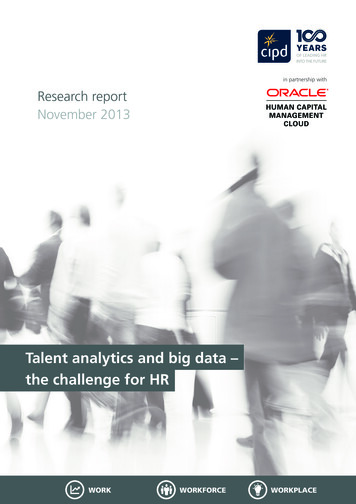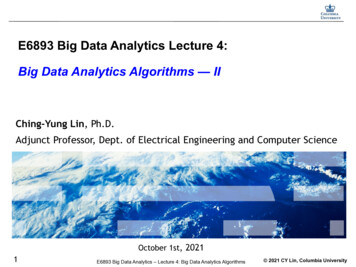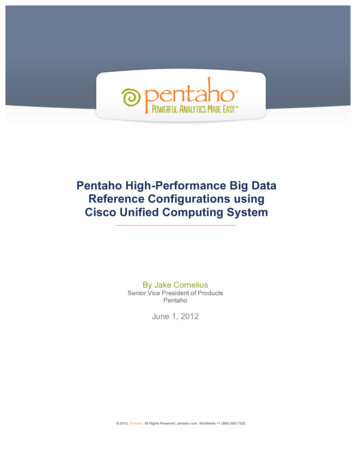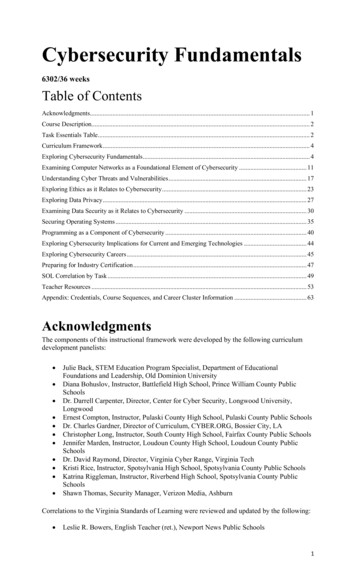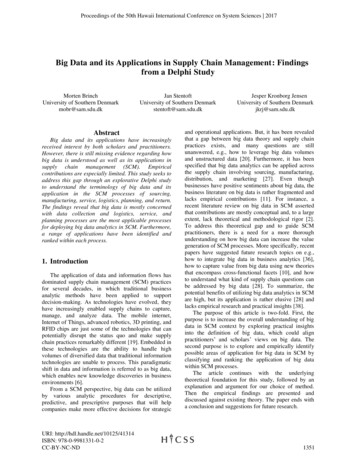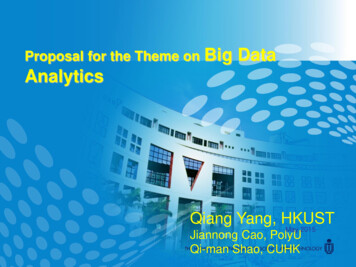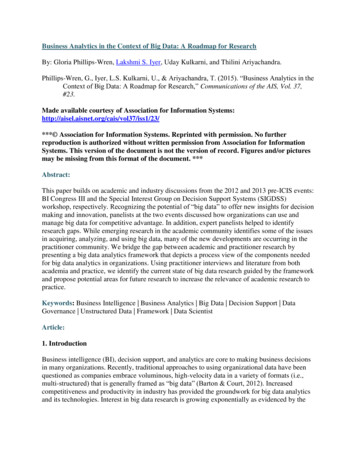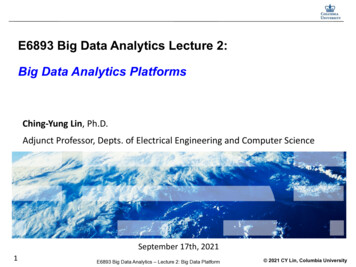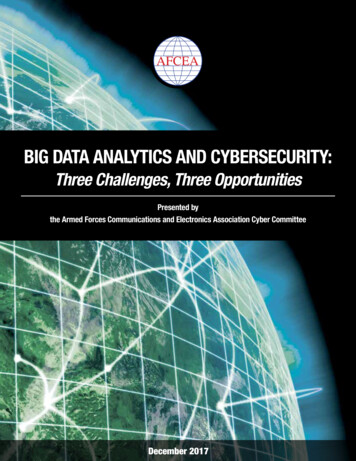
Transcription
BIG DATA ANALYTICS AND CYBERSECURITY:Three Challenges, Three OpportunitiesPresented bythe Armed Forces Communications and Electronics Association Cyber CommitteeDecember 20171
TABLE OFCONTENTS3EXECUTIVE SUMMARY4SCOPE5PROBLEM STATEMENT7APPROACH8THE CHALLENGE OF COMPLEX NETWORKS12THE RISING VALUE OF INFORMATION15ADVERSARIES’ USE OF BIG DATA ANALYTICS17RECOMMENDATIONS17USING BIG DATA TO SECURE COMPLEX NETWORKS18PROTECTING BIG DATA ENVIRONMENTS19THWARTING ADVERSARY BIG DATA ANALYTICS20CONCLUSION21NOTES
EXECUTIVESUMMARYThis white paper by the Armed Forces Communications and ElectronicsAssociation (AFCEA) Cyber Committee provides recommendations onthe applications of big data analytics and data science generally to thecybersecurity domain. It examines ways in which big data can be used toimprove predictive analytics and to detect anomalous behavior that may beindicative of cybersecurity problems such as exploits or attacks. This paperalso examines the special challenges the security of big data environmentspose given the enhanced value of information that is made part of and subjectto analysis within such environments. In addition, it discusses the implicationof the use by foreign intelligence services and cyber criminals of big dataanalytics in the exploitation of large databases and repositories, e.g., the dataextracted from the U.S. Office of Personnel Management (OPM).Overall, this paper recommends research and development the governmentand private sector can conduct regarding ways in which big data analyticscan secure complex networks and environments. It also recommendsenhanced, enterprise-level security regarding big data environments. Finally,it recommends stronger efforts by the Intelligence Community to understandhow adversaries may be using big data analytics to understand the UnitedStates and craft courses of action that affect national interests.3
SCOPEThis white paper discusses ways both the government and the privatesector can use big data analytics to improve predictive analytics relating tocybersecurity problems. It pays special attention to the challenges associatedwith large databases as well as data environments comprising many smallerdatabases, particularly those with national security importance that might beexploited and subjected to big data analytics by adversaries. In addition, itaddresses the need to secure data environments used for national securitypurposes in which big data analytics tools are used to support high-valuedecisions. Given the potential big data analytics hold for the analysis of largedata sets, it also discusses the use of such tools by foreign adversaries andcybercriminals who may wish to understand and intervene in large-scalenational security, political, diplomatic and economic developments in amanner that affects the interests of the United States.4
PROBLEMSTATEMENTComplex networks comprising traditional information technology systems, theInternet of Things, including critical infrastructures, and multiple cloud environmentspresent cybersecurity analysts with difficulty in detecting, preventing and mitigatingsophisticated cyber exploits and attacks. Such complex networks may be difficultto characterize in terms of either baseline behavior or the anomalous behavior thatmay or may not be indicative of a cybersecurity problem. This white paper describesways in which big data analytics can be used to improve our understanding ofbaseline and anomalous behavior caused by cybersecurity problems generally and incomplex, dynamic networks in particular.Progress in this area is vital as networks requiring effective defense become morecomplex. The use of technical tools to compare anomalous and baseline behaviorin the detection of cybersecurity events has proved difficult given the complexity ofcontemporary networks and challenges of differentiating real cybersecurity issuesfrom other issues such as unusual but legitimate user activity; changes in networktopology, particularly in information technology/operational technology (IT/OT)systems; and information technology malfunctions. This challenge, known as thefalse positive problem, results in the presentation of too many indications, most ofwhich are not indicative of a cybersecurity problem, or too few indications, maskingdangerous cyber exploits and attacks.Organizations that rely on information have seen amplification—perhaps by ordersof magnitude—in the value of the information they must protect. Work done in the1980s by Michael Porter of the Harvard Business School identified the conceptof “information intensity.” Porter and others argued that organizations that produceinformation (e.g., Dow Jones) or use information to coordinate the creation andproduction of their products (e.g., Walmart, Boeing) are highly information intensive.The theft or destruction of the information on which these organizations depend canbe fatal. At the same time, the exploitation of such valuable information can be ofsignificant value to the organizations capable of such exploitation.5
Photo credit: Solarseven, ShutterstockPorter’s work in the 1980s, however, should be considered in light of the valuethat big data analytics adds to what had been largely individual facts. Big dataanalytics allows Walmart and other retailers to understand and predict thedemand for the goods on its shelves and to engage in pricing strategies thatconsider customer behavior, competitor activities, supplier pricing and otherfactors. Big data analytics helps pharmaceutical companies structure complexresearch activities and interpret complex results. Financial services firms usebig data analytics to understand future markets; governments use big data tounderstand subjects as diverse as agricultural production and the demographicsof populations that need assistance in the wake of natural disasters. As a result,the information intensity of many organizations has risen in proportion to their useof big data analytics, as has the value of the information aggregated and analyzedusing such tools, raising considerably the stakes in the effective cybersecurity ofthis information.The recent breaches of OPM and other large data environments also call intoquestion the way adversaries are using their big data analytics to understandlarge-scale demographics at a macro level and other trends associated with themillions of people whose records have been exposed. Adversaries may also usebig data analytics to gain significant insight into U.S. national security decisions,the economy and even political dynamics.Understanding how adversaries might use these tools is important tounderstanding the implications of such breaches and to anticipate the use ofthis information by adversaries. Such use of exploited information could includeefforts to analyze trends in U.S. research and development in critical and sensitiveindustrial and technology areas, or even to spot trends in the behavior of personsgranted security clearances. As a result, the U.S. national security and intelligencecommunities should seek to understand how foreign intelligence services andcybercriminals may be using their big data analytics to amplify the benefit theygain through the exploitation of U.S. computer networks.6
APPROACHThe white paper defines specific problems and challenges associated with: securing large-scale data environments; using big data analysis to improve the cybersecurity of complex networks;and understanding how big data analytics can be used by adversaries toenhance the value of information they exploit.It suggests lines of research and development as well as best practices thatshould be employed by government and the private sector, particularly insupport of environments important to national security.To develop this white paper, AFCEA Cyber Committee members: met with leading cybersecurity research and development authorities withinthe federal government and industry; held discussions with the National Counterintelligence and Security Center(NCSC) to understand the intelligence and counterintelligence value ofinformation gleaned by and from big data environments; developed draft findings and recommendations; drafted a presentation to the Cyber Committee; refined the findings and recommendations; developed a stakeholder engagement approach to present the findings andrecommendations; and presented the results to stakeholders.7
THE CHALLENGE OFCOMPLEX NETWORKSEven as computer networks1 are becoming more complex, so too is theircomposition. Newer and emerging networks combine “traditional” informationtechnology, including business applications, media, analytic and other corporatefunctions with the Industrial Control Systems and Supervisory Control and DataAcquisition (SCADA) systems that collected data from and manage today’smanufacturing, energy, transportation and other infrastructures. Such networkscan change frequently as new devices are installed, subnetworks establishedand older equipment decommissioned. More networks than ever are cloudbased; support to industrial infrastructures from cloud-based networks isbecoming a reality. The desire to move information processing workloads amongclouds, known as orchestration, as well as the scale and flexibility of today’scloud infrastructures are creating computer networks with baselines difficultto characterize and in which anomalies caused by cybersecurity exploits andattacks can be difficult to prevent, detect and mitigate.Such networks pose operational and management challenges as well.Responsibility for the management and cybersecurity of such networks maybe distributed and possibly uncoordinated. This diffuse responsibility can beaccompanied by a lack of an integrated view of network operations and behavior.A power grid connected to factories, homes, offices, hospitals, schools andgovernment facilities may encompass devices managed by both the electricalpower grid operator and the myriad organizations, large and small, that thegrid serves. In the near future, smart grids are likely to be connected to smartroads that will mediate access, traffic flows and energy use. It will be difficultenough to characterize baseline behavior of such networks, more difficult toascertain anomalous behavior because of cybersecurity attacks and exploits, andequally difficult to manage cybersecurity across such a disparate environment.Cybersecurity managers may be overwhelmed by problems associated withendpoint protection on networks subject to disparate management andcharacterized by dynamic topologies.Big data analytics may, at least in part, hold the key to meeting this challenge.The Intelligence Community has built an understanding of the challenge big dataposes as unrelenting increases in the volume, velocity and variety of informationwith which it must contend. The community’s struggles with the global data8
environment may yield lessons valuable for the present inquiry. However, perhapsno more useful or simpler definition of big data analytics is available as the one inthe Webopedia, which notes:Big Data analytics is the process of collecting, organizing and analyzing largesets of data (called Big Data) to discover patterns and other useful information.Big Data analytics can help organizations to better understand the informationcontained within the data and will also help identify the data that is mostimportant to the business and future business decisions. Analysts working withbig data basically want the knowledge that comes from analyzing the data.2This definition says as well:High-Performance Analytics RequiredTo analyze such a large volume of data, Big Data analytics is typically performedusing specialized software tools and applications for predictive analytics, datamining, text mining, forecasting and data optimization. Collectively, theseprocesses are separate but highly integrated functions of high-performanceanalytics. Using Big Data tools and software enables an organization to processextremely large volumes of data that a business has collected to determine whichdata is relevant and can be analyzed to drive better business decisions in thefuture.3The Webopedia adds this caution, however:For most organizations, Big Data analysis is a challenge. Consider the sheervolume of data and the different formats of the data (both structured andunstructured data) that is collected across the entire organization and themany ways diverse types of data can be combined, contrasted and analyzed tofind patterns and other useful business information.4This definition is rich in ways pointing to the promise of big data analytics to helpmeet the challenge of securing complex networks, though the cybersecurity ofsuch networks will require other components as well, including new managementmodels that create collective responsibility for the cybersecurity of interconnectedand interdependent networks. It notes that big data analytics can help discoverpatterns of useful, relevant information; can help drive better business decisions;and can be used to find patterns and other useful business information.Work to apply big data analytics to the challenges of cybersecurity has beentaking place for several years. In 2013, authors Tariq Mahmood and Uzma Afzalsurveyed the use of big data analysis in cybersecurity and noted:Analytics can assist network managers particularly in the monitoring andsurveillance of real-time network streams and real-time detection of bothmalicious and suspicious (outlying) patterns.59
The authors make a useful distinction between“malicious” and “suspicious (outlying)” patternsof behavior, demonstrating awareness of theneed to identify activity that may or may not beindicative of a cybersecurity problem but thatstill warrants investigation. In other words, theauthors point to the need to minimize “falsepositives” if big data analytics are to be usefulto cybersecurity.Several companies are tackling the challengeusing big data analytics poses to improvingPhoto credit: Macrovector, Shutterstockcybersecurity. IBM is combining its QRadarAdvisor used as a security enterprise information management (SEIM) toolwith the intelligence built into its Watson supercomputing platform to integratenumerous sensors, unstructured data and network security incidents to create amore predictive environment. Blue Coat and Symantec are creating cloud SEIMsdesigned to detect and manage cybersecurity incidents in cloud environments.Perhaps even greater promise may lie in the adaptation of GE’s Predix platform,which is designed to move the analytics and management of industrial systemsto the cloud. GE’s rationale for creating this platform is compelling; the firm notes:Investment in the Industrial Internet of Things (IIoT) is expected to top 60trillion during the next 15 years6 (a)nd by 2020, over 50 billion assets willconnect to the Internet.7Other Predix features are worth noting. Predix operates at the edge, meaningthat it has insight into and can manage endpoint devices while providingcloud-level efficiency. The platform is designed explicitly with a view towardthe creation and deployment of new analytic applications; its Predix Machineallows for the collection and analysis of data from myriad endpoints, providing astarting point for additional analytic technologies. In addition, the Predix platformitself allows for both high-level integration of connected environment and theirsegmentation to improve security and privacy. Overall, the Predix model arguesfor a combination of both big data analytics and the use of more modern cloudarchitecture for complex networks that include industrial systems also known asoperational technology.Government technology advances also are promising. The Defense AdvancedResearch Projects Agency’s Big Mechanism program “aims to developtechnology to read research abstracts and papers to extract pieces of causalmechanisms, assemble these pieces into more complete causal models, and10
Photo credit: Tommy Lee Walker, Shutterstockreason over these models to produce explanations.”8 Although Big Mechanism isintended to support cancer research, its ability to address “causal models” mighthelp mitigate the challenges associated with false positives, i.e., the problem ofidentifying too many examples of anomalous behavior without clear causality bya cyber exploit or attack.Other government efforts, particularly those undertaken by the Networking andInformation Technology Research and Development (NITRD) Program, also mayoffer promise. The Big Data Interagency Working Group (BD IWG) focuses onresearch and development to improve the management and analysis of largescale data. The group’s purpose is to develop the ability to extract knowledgeand insight from large, diverse and disparate sources of data, includingmechanisms for data capture, curation, management and access. The AFCEACyber Committee recommends this effort be given the additional charter to helpidentify anomalous behavior in the complex networks the nation must secure.Despite these advances and programs, significant hurdles remain. Today’scomplex network environments are managed on a distributed and sometimesmulti-enterprise basis. Agreement will be required to gain access to thedata generated across these interconnected networks that comprise theseenvironments. This agreement will require both data transparency and strongassurance—related to provenance and accuracy—as well as anonymity toprotect personal identifiable information (PII), proprietary information and othersensitive information.11
THE RISING VALUEOF INFORMATIONThe role of information within enterprises is changing; it is growing moreimportant and helping shape the view of cybersecurity. The importance ofinformation can be viewed as an enterprise’s “information intensity.” In thegeneral economy, information—and by extension, its security—is recognizedas an essential aspect of corporate strategy and, more importantly, as anenterprise’s overarching value proposition.The concept of information intensity reflects the recognized value of information.This concept has existed for decades, but it gained currency in the 1980s andhas grown in importance through the present day. Two types of informationintensity were defined in the 1980s, and both are vital to today’s enterprise:product information intensity and value chain information intensity.9Product information intensity measures the extent to which a product isinformation-based (i.e., information-as-product), which is increasingly the case intoday’s global economy in general and in the United States and other advancedeconomies in particular. Any business that provides information-for-value (e.g.,financial reporting and transactions, media and social networking) deliversone or more products that comprise principally or solely information. For suchenterprises, the security of the information they employ and provide affectsmaterially the value of the product they convey to their customers. Their valueproposition can exist and thrive only to the extent cybersecurity and informationassurance relating to provenance, processing and delivery are present.Value chain information intensity is the extent to which information contributes tothe production and delivery of non-information products. Global supply chainsfor the manufacture of aircraft, for example, rely on a complex web of informationranging from specifications and test data to pricing and delivery schedules. Everyelement of this information is crucial to production. In fact, many of the processesused in manufacturing are information-technology controlled, enhancing the levelof information intensity on which these products and their value chains rely. Acybersecurity failure in these value chains can result in faulty parts, dangerousindustrial operations, loss of intellectual property and non-delivery of the productas promised.12
Linked to value chain intensity is the extent to which many physical productssuch as airliners are characterized by an increasing proportion of informationtechnologies. Today’s Boeing Dreamliner, for example, uses computer-based flyby-wire technologies to control critical flight systems. It possesses Internet-basedarchitectures for other systems ranging from avionics to passenger entertainmentsubsystems. In many ways, the Dreamliner is a computer around which someonedesigned an airplane. In Boeing’s own parlance:The 787 Dreamliner, the world’s first e-Enabled commercial airplane, combinesthe power of integrated information and communications systems to driveoperational efficiency, enhance revenue, and streamline airplane maintenance.10Boeing also notes:These tools promise to change the flow of information and create a newlevel of situational awareness that airlines can use to improve operations. Atthe same time, the extensive e-Enabling on the 787 increases the need fornetwork connectivity, hardware and software improvements, and systemsmanagement practices.11The importance of the concept of information intensity is not new. Compellingwork by Michael E. Porter and Victor A. Miller in 198512 described the value ofinformation in both information-as-product and in value chains. The authorsdefined the concept of manufacturing information and distribution systems(MIDS), noting that “an information intensive MIDS will generally bring value to acompany if it adds high value to the product.”13 In today’s world, such systemsare of vital importance.Whether an enterprise delivers information itself as a product or providesproducts that rely on information to empower and mediate their value chains,cybersecurity clearly bears directly on information intensity, corporate strategyand the value proposition an enterprise delivers. Indeed, the cybersecurity ofinformation-intensive products is intrinsic to the value of those products andrises, therefore, to the level of a corporate strategic issue.Recent research increases the importance of the concept of information intensityas well as intensifies the urgency of focusing on cybersecurity. For example,research provides powerful evidence about information-intensive businessesthat produce information-as-product: These businesses should use informationtechnology to disaggregate their production for the purpose of efficiency, just asvalue chain information-intensive manufacturers are building global IT-enabledvalue and production chains.14 Such disaggregation is an important component ofcorporate strategy designed to take advantage of regional and local specializationand cost structures.13
Photo credit: Elnur, ShutterstockAt the same time, securing the IT infrastructures involved is essential for everyaspect of development, production, integration and delivery. Indeed, in thesecases, the ability to provide effective cybersecurity is an essential enablingelement of strategy. It can even be a competitive discriminator vis-à-viscompetitors for which product quality, for example provenance and test data, andthe integrity of information can be enhanced by cybersecurity.The publication of Porter and Miller’s work perhaps came too early for theapplication of the term “big data” used frequently today. Had the term been invogue in the 1980s, Porter and Miller might have added information analysisvalue. This term describes the ability of today’s analytic tools to aggregate manytypes of data from many sources—heterogeneous data in a homogeneousenvironment—to create decisions of significant value. Some examples aredeciding which products to offer to specific consumers at specific prices andtimes, how to deploy valuable medical research and development resources,what crop futures the market might expect, or the likely progression of adangerous epidemic. Tools applied from disciplines such as business intelligence,enterprise resource management and data mining considerably amplify the valueof information.Overall, it’s no surprise that the rise in the importance of information—andthe need to secure it—is followed closely by the attempts globally to stealintellectual property, to gain illegal access to information-as-product, and toenter value chains and achieve the ability to damage the information on whichthose chains rely.14
ADVERSARIES’ USE OFBIG DATA ANALYTICSThe development of large data warehouses and the creation of enterpriselevel data repositories fundamentally has created information targets for ouradversaries that are different than the information environment in the past.Information technology and today’s modern computer networks that combinemyriad streams of information in motion with enormous, complex, structuredand unstructured referential databases or information at rest change thestakes enormously for both those defending today’s information infrastructuresand those seeking to exploit them. In the past, exploitation was subject torequirements for key facts or essential elements of information relating to military,diplomatic, political or economic plans and specific actions. In the past, thoseconducting exploitation wanted to understand force deployments, to gain accessto orders to “attack at dawn,” and to gain insight into a competitor’s diplomatic oreconomic strategy.But the environment has changed. Large-scale databases are being rebuilt asdata warehouses that are designed explicitly for the use of big data analytics.A cogent explanation of this revolution is provided by Health Catalyst, whichexplains the need for the creation of today’s large-scale information environmentsas follows:To effectively perform analytics, you need a data warehouse. A data warehouseis a database of a different kind: an OLAP [online analytical processing]database. A data warehouse exists as a layer on top of another database ordatabases (usually OLTP databases). The data warehouse takes the data from allthese databases and creates a layer optimized for and dedicated to analytics.15Serving these information environments are data centers and architecturesunimaginable in the recent past. Currently, the Lakeside Technology Center is theworld’s largest data center, described as a 1.1-million-square-foot multi-tenantdata center hub owned by Digital Realty Trust and today it is one of the world’slargest carrier hotels and the nerve center for Chicago’s commodity markets,housing data centers for financial firms attracted by the wealth of peering andconnectivity providers among the 70 tenants.16Such data warehouses and their associated infrastructures beg the questionevery sophisticated adversary must ask: Assuming we can gain access to them,what kind of big data analytics can we use to exploit these environments andwhat might we learn?15
That large-scale data environments have become targets is indisputable. Thebreach of the Office of Personnel Management resulted in the compromise ofsome 21.5 million records.17 A breach in 2015 of a voter database in the UnitedStates compromised information contained in some 191 million records,18 whilea compromise of Yahoo’s user base may represent the largest data breach inhistory.19All the breaches are interesting because of their sheer size, but they alsorepresent data of significant variety. The Yahoo breach, for example, mayhave exposed financial information, as well as the affiliations and professionalinterests—and, in some cases, the professional work—of numerous prominentYahoo members.What might an adversary do with information environments this large, this variedand this rich? One might speculate that a foreign power could look for patternsin U.S. research and development, seek to understand important and valuabletrends in the state of technology development for aerospace systems, as wellas monitor clinical trials of new pharmaceuticals. Using big data analytics, othercountries —and potentially cyber criminals—might attempt to understand andpredict important economic developments. With such information in hand, theymight even attempt to preempt and alter these developments in ways favorableto their interests and inimical to U.S. interests.Even greater risks may lie ahead. Newer platforms, such as the one beingdeveloped by C3 IoT, hold the potential to monitor, analyze and predict thebehavior of industrial and infrastructure-based information systems. According toC3 IoT, its new platform provides a complete IoT-platform-as-a-service solutionthat enables the rapid design, development, deployment and operation ofenterprise IoT applications. With an elastic cloud architecture capable of handlingdata sets growing by hundreds of terabytes per day, the platform generatestens of millions of predictions every day for more than 20 full-scale productiondeployments worldwide.20Such tools will allow operators to optimize resource allocation and performance,but they could give adversaries the means to do the same. The use of suchplatforms could help an adversary understand—and possibly alter—the use ofresources in industrial and infrastructure systems in the United States and othercountries.Big data analytics adds substantial value to information. It amplifies the valueof individual facts by allowing them to be integrated into large-scale dataenvironments and to help find patterns useful to decision makers, whetherthose decision makers are military leaders, bankers, aerospace CEOs or leadingresearchers. At the same time, many of the big data analytics tools in use todayare available internationally. Given access to big data environments, there is littlethat would impede the use of these tools by adversaries, and we should expectthat this use is, in fact, taking place today.16
RECOMMENDATIONSUSING BIG DATA TO SECURE COMPLEX NETWORKSPredictive analysis is one of the keys to securing large complex networks.Predictive analysis relies on the collection of a large volume of data, thenormalization of the data set, correlation of data to related data sets and securityrequirements to reduce false positives, and analytical
the applications of big data analytics and data science generally to the cybersecurity domain. It examines ways in which big data can be used to improve predictive analytics and to detect anomalous behavio


